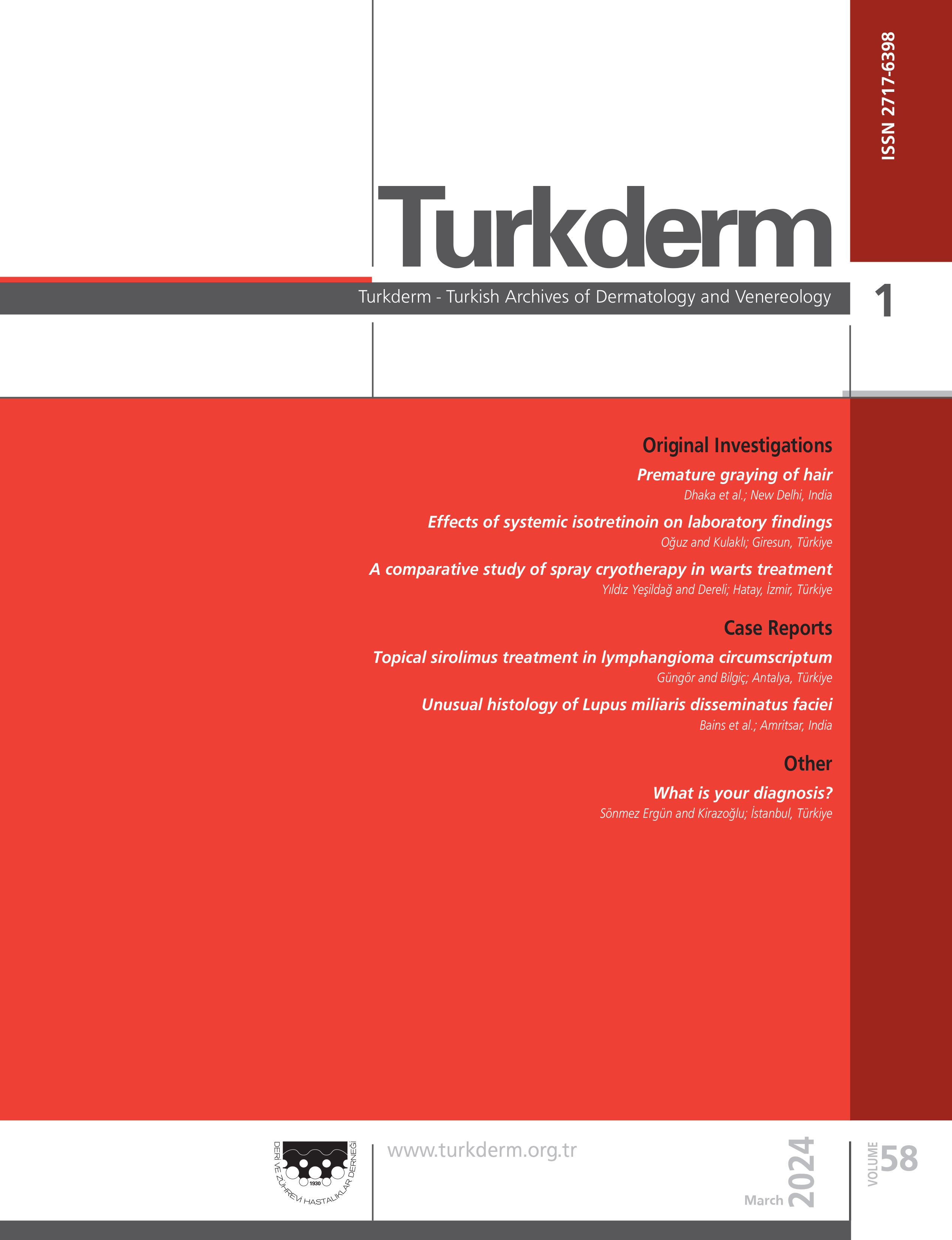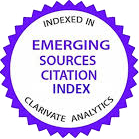Volume: 50 Issue: 1 - 2016
| EDITORIAL | |
| 1. | Editorial Page 1 Abstract | |
| ORIGINAL INVESTIGATION | |
| 2. | Micrographic surgey for the treatment of non-melanoma skin cancers of the head and neck Gonca Elçin, Serdar Özer, Özay Gököz, Ömer Taşkın Yücel, Gül Erkin Özaygen, Tülin Akan doi: 10.4274/turkderm.23334 Pages 2 - 9 Amaç: Mikrografik cerrahi intraoperatif olarak mikroskop kontrolünde uygulanan ve horizontal kesitlerle %100 sınır kontrolü sağlayarak tümörün tamamının çıkarılmasını hedefleyen bir cerrahi yöntemdir. Mikrografik cerrahide tümör dar güvenlik sınırları kullanılarak kademeli çıkarıldığı için sağlam doku en yüksek oranda korunur. Yöntem kür oranlarının yüksekliği ve doku koruyuculuğu nedeniyle yüksek riskli melanom dışı deri kanserlerinde tedavi seçeneği olarak önerilmektedir. Ülkemizde dermatolojik cerrahi uygulamalar arasında mikrografik cerrahi rutin olarak yer almamaktadır. Bu çalışmanın amacı mikrografik cerrahi yönteminin seçilmiş hastalar için uygulanabilmesini sağlamaktı. Gereç ve Yöntem: 2010-2015 tarihleri arasında 102 hastaya ait (53 erkek ve 49 kadın), 116 melanom dışı deri kanseri (113 bazal hücreli karsinom ve 3 skuamöz hücreli karsinom) mikrografik cerrahi ile tedavi edildi. Tümörlerin tümü baş veya boyunda lokalize idi ve rekürrens açısından en az 1 yüksek risk faktörü taşıyordu. Mikrografik cerrahi 2010-2013 yılları arasında Münih metoduyla, 2013-2015 yılları arasında ise Mohs cerrahisi kullanılarak uygulandı. Bulgular: Hastaların yaş ortalaması 65,86±12,33, aralığı 33-90 yaş idi. Tümörlerin 112si başa yerleşirken, 4ü ise boyun yerleşimli idi. Tümörsüz sınıra ulaşmak için uygulanan mikrografik cerrahi kademe sayısı 55 (%47,41) tümör için 1 kademe, 55 tümör için 2 kademe iken 8 (%6,89) tümör için 2 kademeden fazla olarak gerçekleşti. Defektlerden 6sı sekonder yara iyileşmesine bırakılırken, 31i primer olarak onarıldı, 13 defekte tam kat deri grefti uygulanırken, 66 defekt ise flep ile onarıldı. Sonuç: Bu çalışma ile mikrografik cerrahi Türkiyede 5 yıl süreyle aralıksız uygulanmıştır. Bu çalışmanın sonuçları mikroskobik eradikasyonun tümörlerin yarısından fazlasında birden fazla mikrografik cerrahi kademesi gerektirdiğini dolayısıyla melanom dışı deri kanserlerinin klinikte gözle görünenin ötesinde yayılma eğilimi olduğunu göstermektedir. Sonuçlar fonksiyonel ve kozmetik açıdan sağlam derinin korunmasının kritik öneme sahip olduğu baş ve boyun yerleşimli tümörlerde mikrografik cerrahinin uygulanması gerekliliğini desteklemektedir. Background and Design: Micrographic surgery is an intraoperative microscope-controlled surgery which aims at the excision of the entire tumor by achieving 100% control of the surgical margins with horizontal sectioning. In micrographic surgery, the healthy skin is preserved maximally due to the stepwise excision of the tumor using narrow margins. Due to its highest cure rates and maximal tissue preserving properties, it is the treatment of choice for high-risk non-melanoma skin cancers. Micrographic surgery is not routinely included in the dermatologic surgical procedures in Turkey. The aim of this study was to provide the availability of micrographic surgery for selected patients. Materials and Methods: During 2010-2015, 116 non-melanoma skin cancers that belong to 102 patients (53 male, 49 female) were treated with micrographic surgery. All tumors were located on the head or neck, and exhibiting at least one high-risk factor for recurrence. Micrographic surgery was performed with the Munich method between 2010 and 2013, and with Mohs surgery between 2013 and 2015. Results: The mean age of patients was 65.86±12.33 years (range: 33-90 years). The localization of the tumors was the head (n=112) and the neck (n=4). The number of micrographic surgery sessions to eliminate the tumor was 1 session for 55 (47.41%), 2 sessions for 55, and more than 2 sessions for 8 (6.89%) of the tumors. Six of the defects were left for secondary intention healing, 31 were repaired primarily and 13 defects were repaired with full thickness skin grafts whereas 66 were repaired with flaps. Conclusion: The results of this study showed that microscopic eradication of non-melanoma skin cancer necessitates more than one session for more than half of the cases, illuminating that microscopic extension of non-melanoma skin cancer beyond clinically apparent tumor is very likely. The results support that for tumors located on the head and neck where healthy skin should be preserved maximally for functional and cosmetic reasons, the use of micrographic surgery is a necessity. |
| 3. | Occupational eczema: Practice differences between dermatologists, workplace doctors and family practitioners Emek Kocatürk Göncü, Mehmet Melikoğlu, Nagihan Tarikçi, Mustafa Tamyürek, Dilek Toprak, Filiz Topaloğlu Demir, Zeynep Topkarcı doi: 10.4274/turkderm.21208 Pages 10 - 16 Amaç: Mesleki egzama sık görülen bir meslek hastalığıdır ancak hastalık başlangıcı ile tanısı arasındaki süre oldukça uzundur. Semptomların başlangıcı ile tanı arasındaki süre uzadıkça prognoz da kötüleşmektedir. Tanı ve tedavi aşamasında dermatologların yanı sıra aile hekimleri ve işyeri hekimleri de rol almaktadır. Çalışmamızda mesleki egzama tanısında ve tanı sonrası hastaların ele alınışında bu hekim grupları arasında farklılık olup olmadığını ve mesleki egzamalar konusundaki bilgi düzeyi ve eğitim açığının hangi aşamalarda ve konularda yaşandığını tespit etmeyi amaçladık. Gereç ve Yöntem: Bu tanımlayıcı çalışma Ocak 2012-Aralık 2013 yılları arasında gerçekleştirildi. Dermatolog, aile hekimi ve işyeri hekimlerine e-posta yoluyla 15 soru içeren bir anket gönderildi. Verilerin analizi SPSS 22.0 programı kullanılarak yapıldı. Bulgular: Çalışmaya 313ü dermatolog, 53ü aile hekimi ve 27si işyeri hekimi olmak üzere toplam 393 kişi katıldı. Çalışmaya katılanların %63,4ü ayda 10-100 el egzaması hastası muayene etmekteydi. Katılımcıların %85,9u el egzaması olan hastalara her zaman ne iş yaptığını sorduğunu ifade etti. El egzaması olan hastalara iş yerinde maruz kaldığı maddelerin neler olduğunu ise %71,7si her zaman yanıtını verdi. Mesleğe bağlı el egzaması düşündüğünüz hastalarda hangi yolu seçersiniz? sorusuna sevk ederim ve mesleği bırakmasını söylerim yanıt oranı aile hekimi ve işyeri hekimlerinde daha yüksekti. İşyeri hekimi ve aile hekimleri dermatoloji uzmanına sevk ederken, dermatologların yama testi yapılan bir dermatoloji kliniğine ya da meslek hastalıkları hastanesine sevk ettikleri tespit edildi. Katılımcıların %91,2si mesleki egzamalar konusunda daha fazla bilgi sahibi olmak istediğini belirtirken, en çok bilgi sahibi olunmak istenen konunun işyerlerinde maruz kalınan alerjen/irritan maddeler olduğu tespit edildi. Sonuç: Yaptığımız anket sonucunda katılan hekimlerin büyük çoğunluğu mesleki egzamalar konusunda daha fazla bilgi sahibi olmak istediklerini belirtmişlerdir. Mesleki egzamalar konusunda kurs, kongre, kitap ya da derlemeler gibi eğitici faaliyetlerin daha fazla yapılması gerekmektedir. Ayrıca mesleki egzamalı hastaların tanısı, bakımı ve rehabilitasyonu konusunda özelleşmiş merkezlerin kurulması gerekmektedir. Background and Design: Occupational hand eczema is a commonly encountered problem. The time interval between onset and diagnosis is often long and this leads to increased morbidity. Besides dermatologists, family practitioners and workplace doctors play a role in the diagnosis and treatment of the disease. We aimed in our study to evaluate the discrepancies in how the disease is diagnosed and how the patients are handled between these specialty groups. We also aimed to determine the level of knowledge about occupational eczema and how the knowledge could be increased. Materials and Methods: This was a descriptive study performed between January 2012 and December 2013. A questionnaire was sent via email to dermatologists, family practitioners and workplace doctors. Results: A total of 393 doctors, including 313 dermatologists, 53 family practitioners and 27 workplace doctors were enrolled in the study. Sixty-three percent of the doctors were examining 10-100 patients with hand eczema in a mouth. Eighty-five percent was always asking the occupation of the patient. 71.7% was asking everytime what materials are handled in the work place. The answers to the question What is your approach to the patient after you diagnose occupational hand eczema was I refer the patient and I tell the patient to quit the job was higher in family practitioners and family doctors. The center for referral was dermatologists for the workplace doctors and family practitioners while dermatologists referred the patients to a clinic performing patch tests or occupational diseases centers. 91.2% of the responders stated that they wanted to have more knowledge about occupational eczema and the issue of wonder mostly found was the allergens/irritants encountered in the workplace. Conclusion: A high number of the respondents stated that they wanted to gain more knowledge about occupational eczema. More courses, meetings, seminars are required to be performed on this topic and more papers or text-books concerning the subject should be published. In addition, special centers for the diagnosis, care and rehabilitation of these patients are needed. |
| 4. | Do the fusion regions have a role in the development of basal cell carcinoma? Serra Kayaçetin, Ülker Gül doi: 10.4274/turkderm.58159 Pages 17 - 20 Amaç: Bazal hücreli kanser (BHK) en sık gözlenen deri kanseridir. Hastalığın etiyopatogenezi henüz tam olarak aydınlatılamamıştır. Etiyopatogenezde çeşitli çevresel ve genetik faktörlerin rol oynadığına inanılmaktadır. Son yıllarda etiyopatogenezde bahsedilen faktörlerden biri de füzyon alanlarıdır. Çalışmamızda füzyon alanlarını daha çok içeren anatomik bölgelerde BHK sayısının daha fazla olup olmadığını araştırmayı amaçladık. Gereç ve Yöntem: Çalışmaya histopatolojik raporunda anatomik bölgesi belirtilmiş 328 BHK olgusu alındı. Füzyon alanları, Tessierin yayınındaki haritalandırma sistemine göre belirlendi. İlk olarak yüzdeki her bir anatomik bölgeye düşen toplam füzyon alanı sayısı hesaplandı. Daha sonra, her bir anatomik bölgede bulunan BHK sayısı ile aynı anatomik bölgede bulunan füzyon alanı sayısı birbiri ile kıyaslandı. Sonuç olarak bulgular neden-sonuç ilişkisi açısından yorumlandı. Bulgular: Füzyon alan sayısı açısından en önemli anatomik bölge alın ve dudaktı. Alın ve dudakta 11 füzyon alanı bulunmaktaydı. Alında 34 ve dudakta 14 BHK gözlendi. Göz çevresinde 10 füzyon alanı vardı ve her 2 göz çevresinde toplam 74 BHK tesbit edildi. Ancak BHKnın en çok bulunduğu (135) burun bölgesinde ise 9 füzyon alanı tespit edildi. Sonuç: Füzyon alanının çok olduğu anatomik bölgelerde, füzyon alanının daha az bulunduğu anatomik bölgelere kıyasla daha fazla BHKya rastlanılmadı. Sonuç olarak BHK gelişiminde, tek başına füzyon alanlarının etiyopatogenetik bir öneme sahip olmadığı görülmektedir. Background and Design: Basal cell carcinoma (BCC) is the most frequently observed cancer. Its ethiopathogenesis is not totally clarified. In recent years one of the factors mentioned on ethiopathogenesis is fusion regions. In our study we aimed to investigate whether the number of BCC is more or not in anatomic areas which contain more fusion regions. Materials and Methods: Three hundred twenty-eight BCC case whose anatomic region is indicated in histopathology report is taken into study. Fusion regions are determined according to the mapping system given in Tessiers publication. First the number of total fusion region for each anatomic area on face is calculated. Then, the number of BCC located in each anatomic area and the number of fusion region located in the same anatomic area are compared. In conclusion findings are commented with respect to cause result relationship. Results: The most important anatomic areas with respect to fusion region number were forehead and lip. In forehead and lip there were 11fusion regions. 34 BCC on forehead and 14 BCC on lip are observed. There were 10 fusion regions on around the eye and a total of 74 BCC were observed on both periorbital area. But 9 fusion area is detected on nose area where BCC is mostly present (135). Conclusion: More BCC is not observed in anatomic areas where fusion region is plenty compared to anatomic areas where fusion region is less. As a result; in BCC development, it is seen that only fusion regions do not have ethiopathogenetic importance. |
| 5. | Evaluation of the quality of life in patients with genital warts Yasemin Erdem, Güzin Özarmağan doi: 10.4274/turkderm.78477 Pages 21 - 24 Amaç: Genital siğil oldukça sık görülen, cinsel yolla bulaşan enfeksiyondur. Hastalarda yaşam kalitesini özellikle psikososyal açıdan olumsuz etkilemektedir. Bu çalışmada hasta ve kontrol grubu karşılaştırılarak yaşam kalitesine etkilerinin araştırılması amaçlanmıştır. Gereç ve Yöntem: Seksen hasta ve 75 sağlıklı gönüllü çalışmaya dahil edildi. Hasta grubuna Kısa-form (KF)-36 ve Dermatoloji yaşam kalite indeksi (DYKİ); kontrol grubuna KF-36 anketi uygulandı. Elde edilen veriler klinik ve sosyo-demografik veriler eşliğinde hasta ve kontrol grubu karşılaştırılarak değerlendirildi. Bulgular: Hasta grubunda kontrol grubuna göre KF-36 alt boyutlarından genel sağlık algısı, vitalite ve mental sağlık alanlarında anlamlı derecede etkilenme olduğu görüldü. DYKİ puan ortalaması 5,14±4,13 olarak bulundu. Kadın hastalarda erkek hastalara göre KF-36 tüm alt boyutlarda puanlar istatistiksel olarak anlamlı derecede düşük bulundu. Klinik özellikler ve yaşam kalitesi arasında anlamlı ilişki saptanmadı. Sonuç: Genital siğil yaşam kalitesini olumsuz etkileyen, hastalarda psikososyal sorunlara ve cinsel yaşam değişikliklerine yol açan bir hastalıktır. Background and Design: Genital warts, a very common sexually-transmitted infection, negatively affect the quality of life of patients especially from the psychosocial point of view. In this study, we aimed to investigate the effects of genital warts on the quality of life by comparing patient and control groups. Materials and Methods: Eighty patients and 75 healthy individuals were included in the study. The 36-item Short-form health survey (SF-36) and Dermatology life quality index (DLQI) were administered to patients whereas the control group was given only the SF-36. The obtained data were evaluated together with the clinical and demographical data by comparing the patient and control groups. Results: According to the sub-dimensions of the SF-36, a significant effect was observed in the patient group compared to the control group for the general health, vitality and mental health. The average DLQI score was 5.14±4.13. In all sub-dimensions of SF-36, the scores in female patients were found to be statistically significantly lower than in male patients. No significant correlation was determined between clinical characteristics and quality of life. Conclusion: Genital warts are a disease which negatively affects the quality of life and results in psychosocial problems and changes in sexual activity. |
| CASE REPORT | |
| 6. | Cellular dermatofibroma: Benign or malign? Gülcan Saylam Kurtipek, Arzu Ataseven, İlkay Özer, Meryem İlkay Eren Karanis doi: 10.4274/turkderm.03342 Pages 25 - 27 Dermatofibromun ya da benign fibröz histiositomun (FH) farklı klinik ve histopatolojik tipleri tanımlanmıştır. Sellüler dermatofibrom ise benign FHlerin yaklaşık %5ini oluşturur. Literatürde inguinal lenf nodu ve akciğer metastazı görülen olgular bildirilmiştir. Burada; tibia distalinde 3x4 cm boyutlarında nodüler kitle şikayeti ile polikliniğe başvuran ve toplam eksizyon sonrası histopatolojik tanısı sellüler dermatofibrom ile uyumlu 25 yaşında kadın sunulmaktadır. Literatürde özellikle akciğer ve inguinal bölge metastazı olan olgular bildirilmiştir. Biz bu olguyu; sellüler dermatofibromun nadir görülmesi ve uzak metastaz yapabilme potansiyelini vurgulamak için sunduk. Different clinical and histopathologic types of dermatofibromas (benign fibrous histiocytoma (FH)) have been defined. Cellular dermatofibroma accounts for approximately 5% of benign FH. In the relevant literature, there are reported cases of lung metastases and inguinal lymph node metastases. In this paper we present a 25-year-old women who presented to our outpatient clinic with 3x4 cm nodule mass in the distal tibia and received the histopathological diagnosis of cellular dermatofibroma after total excision. In the literature, cases of dermatofibroma metastasizing to the lung and inguinal lymph nodes have been reported. We present this rare case of cellular dermatofibroma to highlight its potential for distant metastasis. |
| 7. | A case of angioedema-like atypic scleromyxedema responding to treatment with steroid Ayşegül Polat, Yelda Kapıcıoğlu, Nurhan Şahin, Mikail Yılmaz doi: 10.4274/turkderm.04809 Pages 28 - 30 Liken miksödematoz, deride müsin birikimi ve fibroblast artışıyla seyreden, tiroid bozukluklarının eşlik etmediği kronik, sistemik, enflamatuvar bir dermatozdur. Genellikle paraproteinemiler ile birlikte görülür. Klinik olarak skleromiksödem (papüler müsinöz), lokalize liken miksödematozus, atipik liken miksödematozus olarak sınıflandırılır. Tedavisi oldukça güç olan hastalığın etiyopatogenezi halen tam anlaşılamamıştır. Burada anjiyoödem benzeri başlangıç gösterip, hızlı gelişen ve steroid tedavisine cevap veren monoklonal gamopatisiz atipik bir skleromiksödem olgusu sunulacaktır. Lichen myxedematosus is a chronic, inflammatory, systemic dermatose characterized by dermal musin deposition and increased fibroblasts in the absence of thyroid dysfunction. It is usually seen together with paraproteinemia. It is clinically classified as scleromyxedema (papular mucinosis), localized lichen myxedematosus, and atypical lichen myxedematosus. Etiopathogenesis of the disease which is very difficult to treat is still unknown. Herein, we present a case of atypical scleromyxedema without monoclonal gammopathy mimicking angioedema, rapidly developing and responding to steroid treatment. |
| 8. | Pseudoxanthoma elasticum-like papillary dermal elastolysis Seval Erpolat, Hacer Haltaş doi: 10.4274/turkderm.78642 Pages 31 - 33 Psödoksantoma elastikum-benzeri papiller dermal elastolizis (PKE-PDE), klinik olarak PKEye benzeyen papüllerle karakterize ve histolojik olarak papiller dermiste kısmi ya da tam elastik doku kaybı ile karakterize nadir kazanılmış, non-enflamatuvar bir hastalıktır. Burada 60 yaşında PKE-PDE tanısı alan kadın olgu nadir görülmesi nedeniyle sunulmaktadır. Pseudoxanthoma elasticum-like papillary dermal elastolysis (PXE-PDE) is a rare acquired non-inflammatory disorder characterized by papules that clinically resemble PXE and histologically by a total or partial loss of elastic fibers in the papillary dermis. It typically affects elderly women. Here, we present a 60-year-old woman diagnosed with PXE-PDE which is a rarely encountered condition. |
| LETTER TO THE EDITOR | |
| 9. | Investigation of cytokine gene polymorphisms in patients with psoriasis vulgaris Çiğdem Kekik Çınar, Gonca Emel Karahan, Sonay Temurhan, Serpil Pirmit, Nahide Onsun, Fatma Savran Oğuz doi: 10.4274/turkderm.68926 Pages 34 - 38 Psoriasisde enflamasyondan sorumlu Th hücrelerin ürettikleri proenflamatuvar sitokinler hastalığın patogenezinde önemli yer tutarlar. Bu çalışmanın amacı, psoriasis hastalığı ile patogenezde rol alan tümör nekrozu faktörü alfa (TNF-α), interlökin (İL-10), interferon (İFN-γ), İL-6, dönüştürücü büyüme faktörü beta (DBF-β) gen polimorfizmleri arasındaki olası ilişkiyi saptamaktır. Çalışmaya psoriasis tanısı konmuş 89 hasta ile 201 sağlıklı birey dahil edilmiştir. Hasta grubu, erken başlangıçlı (grup 1) ve geç başlangıçlı (grup 2) olarak ikiye ayrılmıştır. İki grubun sitokin gen polimorfizmleri polimeraz zincir reaksiyonu-sekans spesifik primer yöntemi ile ticari kit kullanılarak tiplenmiştir. Tüm hastalar ile grup 1 hastalarını ayrı ayrı kontrol grubu ile karşılaştırdığımızda DBF-β TT/GC haplotipi hastalarda anlamlı olarak yüksek bulundu (p<0,05). Grup 1 ve grup 2 karşılaştırıldığında İFN-γ AA genotipi grup 1 hastalarda anlamlı olarak yüksek değerlendirildi (p<0,05). Bonferroni testi sonrası bu anlamlılık gözlenemedi. Orta şiddetli semptom gösteren bireylerde anlamlı olarak yüksek bulunan İL-10 GCC/GCC genotipi doğrulama sonucu anlamlılığını kaybetti. Bu veriler, tüm hasta ve kontrol grubundaki tek farkın DBF-β TT/GC genotipinin hastalarda anlamlı olarak yüksek olduğunu gösterdi. Th1 sitokinlerinin aktivitesi ile ilişkili diğer birçok genin varlığı nedeniyle psoriasisin moleküler temelini belirlemek için yeni çalışmalar gereklidir. Psoriasis is associated with cutaneous and systemic overexpression of several proinflammatory cytokines. The aim of this study was to investigate the relationship between susceptibility to psoriasis and polymorphisms of tumor necrosis factor alpha (TNF-α), interferon gamma (INF-γ), interleukin (IL-10), IL-6 and transforming growth factor beta (TGF-β). Eighty-nine patients with psoriasis and 201 healthy controls were enrolled into the study. The patient group was divided into 2 subgroups as early-onset (group 1) and late-onset (group 2). The cytokine gene polymorphisms in each group were determined by polymerase chain reaction-single specific primer. When the whole and only group 1 patients were compared with the controls, TGF-β TT/GC genotype was significantly high in the whole and group 1 patients. When we compared the group 1 and group 2, the frequency of IFN-γ AA genotype was found to be significantly high in group 1 which lost significance after Bonferroni correction. Patients with moderate symptoms had a significantly high frequency of IL-10 GCC/GCC genotype that did not remain significant after correction. These data from our small group of patients demonstrated that the only significant difference between the whole patient group and the controls was for TGF-β TT/GC genotype with a higher frequency in the patients. Due to the involvement of many other genes relating to the activity of Th1 cytokines, further studies are required to determine the molecular basis of the susceptibility to psoriasis. |
| 10. | Acı Kaybımız Serap UtaşPages 39 - 40 Abstract | |






















